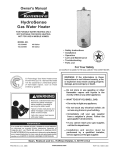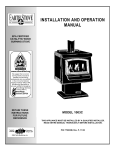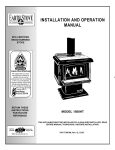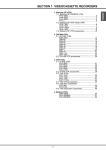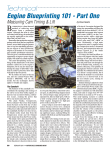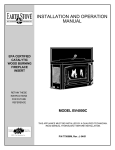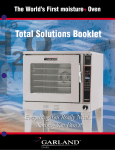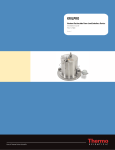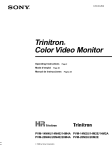Download Lennox Hearth 1900HT-M User's Manual
Transcript
INSTALLATION AND OPERATION
MANUAL
EPA CERTIFIED
WOOD BURNING
STOVE
RETAIN THESE
INSTRUCTIONS
FOR FUTURE
REFERENCE
MODEL 1900HT-M
THIS APPLIANCE MUST BE INSTALLED BY A QUALIFIED INSTALLER. READ
ENTIRE MANUAL THOROUGHLY BEFORE INSTALLATION.
P/N 775002M, Rev. F 11/03
IMPORTANT WARNINGS
CAUTION: PLEASE READ THIS ENTIRE MANUAL BEFORE YOU INSTALL AND USE YOUR NEW ROOM
HEATER. FOR YOUR SAFETY, FOLLOW THE INSTALLATION, OPERATION AND MAINTENANCE INSTRUCTIONS EXACTLY, WITHOUT DEVIATION. FAILURE TO FOLLOW THESE INSTRUCTIONS MAY RESULT IN
PROPERTY DAMAGE, BODILY INJURY, OR EVEN DEATH. IF THIS APPLIANCE IS NOT PROPERLY INSTALLED,
A HOUSE FIRE MAY RESULT. CONTACT YOUR LOCAL BUILDING OR FIRE OFFICIALS ABOUT RESTRICTIONS
AND INSTALLATION INSPECTION REQUIREMENTS IN YOUR AREA.
1.
2.
3.
4.
5.
6.
7.
8.
9.
If utilizing an older chimney, it must be inspected for adequate serviceability. Refer to
the heading Chimney Inspection on page 9 of
this manual.
The minimum clearances must be maintained
for all combustible surfaces and materials including; furniture, carpet, drapes, clothing,
wood, papers, etc. Do not store firewood
within this clearance space. Failure to maintain clearances to all combustibles may result
in a house fire.
This appliance requires non-combustible floor
protection as outlined in this manual (see Floor
Protection on page 5 for additional information).
Minimum ceiling height must be 7 feet (213 cm)
(measured from base of appliance to ceiling).
DO NOT CONNECT THIS UNIT TO A CHIMNEY
FLUE CONNECTED TO ANOTHER APPLIANCE.
Do not connect this appliance to air ducts or
any air distribution system.
PREVENT CREOSOTE FIRE: Inspect and clean
chimney frequently. Under certain conditions
of use, creosote buildup may occur rapidly. Inspect chimney connector and chimney twice
monthly and clean if necessary. Using green
or inadequately seasoned wood can greatly increase creosote buildup. Use dry wood to
minimize creosote buildup.
USE SOLID WOOD FUEL ONLY: This appliance
is approved for burning dry seasoned natural
wood only. CAUTION: BURN UNTREATED
WOOD ONLY. DO NOT BURN GARBAGE OR
FLAMMABLE FLUIDS SUCH AS GASOLINE,
NAPHTHA OR ENGINE OIL.
Never use gasoline, gasoline-type lantern fuel,
kerosene, charcoal lighter fluid, or similar liquids to start or "freshen up" a fire in this
heater. Keep all such liquids well away from
the heater while it is in use.
10. DO NOT OVERFIRE: If heater or chimney connector glows, you are overfiring. Overfiring this
appliance could cause a house fire. Overfiring
is a condition where the appliance is operated
at temperatures above its design capabilities.
Overfiring can be caused by improper installation, improper operation, lack of maintenance
or improper fuel usage. Damage caused from
overfiring is NOT covered under the manufacturer’s limited warranty.
11. NEVER LEAVE AN UNATTENDED STOVE
BURNING ON HIGH. Operation of the stove
with the primary air control at its highest burn
rate setting for extended periods can cause
dangerous overfiring conditions. The primary
air control should only be positioned at the
highest setting during start-up procedures and
for short durations. When leaving the stove
unattended ensure that the primary air control
is set to the low or medium low range.
12. Use a metal container with a tight fitting lid to
dispose of ashes.
13. IN THE EVENT OF A COMPONENT FAILURE,
USE ONLY COMPONENTS PROVIDED BY THE
MANUFACTURER AS REPLACEMENT PARTS.
14. Burning any kind of fuel uses oxygen from the
dwelling. Be sure that you allow an adequate
source of fresh air into the room where the
stove is operating (see Ventilation and Outside
Combustion Air, page 7).
15. CAUTION: HOT WHILE IN OPERATION. An appliance hot enough to warm your home can
severely burn anyone touching it. Keep children, clothing and furniture away. Contact
may cause skin burns. Do not let children
touch the appliance. Train them to stay a safe
distance from the unit.
16. Do not operate this appliance without the firebox baffle brick properly installed.
17. Build fires directly upon the brick hearth inside
the stove. Do not use grates, irons or any
other method to elevate the fire.
18. SAVE THESE INSTRUCTIONS.
19. See the listing label located on the back of
stove (or see Safety/Listing Label on page 24).
PAGE 2
TABLE OF CONTENTS
CONGRATULATIONS ON THE PURCHASE OF
YOUR NEW WOODSTOVE MANUFACTURED BY
LENNOX HEARTH PRODUCTS.
Important Warnings ................................................ 2
Testing/Listing, EPA, Using this Manual.................. 3
When you purchased your new woodstove, you
joined the ranks of thousands of concerned individuals whose answer to their home heating needs
reflects their concern for aesthetics, efficiency and
our environment. We extend our continued support
to help you achieve the maximum benefit and enjoyment available from your new wood stove.
Planning Your Installation ..................................... 4-6
Manufactured (Mobile) Home Requirements ...........7
Installation .......................................................... 7-12
Product Features and Controls ..............................13
It is our goal at Lennox Hearth Products to provide
you, our valued customer, with an appliance that
will ensure you years of trouble free warmth and
pleasure.
Care and Operation .......................................... 13-16
Recommended Fuel ...............................................16
Maintenance ..................................................... 17-18
Thank you for selecting a Lennox Hearth Products
stove as the answer to your home heating needs.
Troubleshooting ......................................................19
Sincerely,
All of us at Lennox Hearth Products
Replacement Parts List..................................... 20-21
Optional Accessories ..............................................22
Specifications..........................................................23
Safety/Listing Label.................................................24
EPA Label ..............................................................25
Ownership Records ...............................................26
TESTING/LISTING
Model 1900HT-M has been Safety tested to U. L. Standards #1482, 5th Edition; ULC-S627 by OMNI Test
Laboratories Inc, Beaverton, Oregon; Report Number
#030-S-03-2.
EPA CERTIFICATION
This heater meets EPA particulate matter (smoke) control requirements for noncatalytic wood heaters built on
or after July 1, 1990.
PACKAGING LIST
This appliance is packaged with an accessory package,
which contains the following:
One - Installation and operation instructions manual.
One - Warranty.
One - Marble set (for stove top and ash lip).
One - Insulation pad and strips. Place pad and strips
under top marble.
USING THIS MANUAL
Please read and carefully follow all of the instructions
found in this manual. Please pay special attention to
the safety instructions provided in this manual. The
Homeowner’s Care and Operation Instructions included
here will assure you have many years of dependable
and enjoyable service from your appliance.
PAGE 3
PLANNING YOUR INSTALLATION
QUESTIONS TO ASK LOCAL BUILDING OFFICIAL
A correct installation is critical and imperative for reducing fire hazards and perilous conditions that can arise
when wood burning appliances are improperly installed.
The installer must follow all of the manufacturers’ instructions.
The installation of a wood burning appliance must conform to local codes and applicable state and federal
requirements. Familiarity with these requirements before installation is essential. Important considerations to
discuss with local building officials include:
1. Applicable codes (i.e. Uniform Mechanical Code,
State or Regional Codes)
Electrical codes: Optional Blower Assemblies have
a flexible electrical cord that must be electrically
grounded per local codes or per electrical codes:
In USA, NEC, ANSI/NFPA 70-1987
In Canada, CSA C22.1
WARNING: ELECTRICAL GROUNDING INSTRUCTIONS: THIS APPLIANCE IS EQUIPPED WITH A
THREE-PRONG (GROUNDING) PLUG FOR YOUR
PROTECTION AGAINST SHOCK HAZARD AND
SHOULD BE PLUGGED DIRECTLY INTO A PROPERLY GROUNDED THREE-PRONG RECEPTACLE.
DO NOT CUT OR REMOVE THE GROUNDING
PRONG FROM THIS PLUG.
DO NOT ROUTE
POWER CORD UNDER OR IN FRONT OF APPLIANCE.
2. Local amendments?
3. Is a permit required - cost? (You may wish to contact your insurance company to ask if they require
this)
4. Is outside combustion air required?
5. Rooms where the installation is not allowed?
SMOKE DETECTORS
Since there are always several potential sources of fire
in any home, we recommend installing smoke detectors. If possible, install the smoke detector in a hallway
adjacent to the room (to reduce the possibility of occasional false activation from the heat produced by the
stove). If your local code requires a smoke detector be
installed within the same room, you must follow the requirements of your local code. Check with your local
building department for requirements in your area.
PAGE 4
PLANNING YOUR INSTALLATION
FLOOR PROTECTION
This appliance requires non-combustible floor protector for
ember protection. If the floor protection is to be stone, tile,
brick, etc., it must be mortared or grouted to form a continuous
non-combustible surface. If a chimney connector extends
horizontally over the floor, protection must cover the floor under the connector and at least 2" (51 mm) to either side.
The floor protection must extend completely beneath the
stove and to the front, sides, and rear as indicated:
USA REQUIREMENTS:
16" to the front of the fuel door glass
4½" beyond the sides of the pedestal base
0" to the back of the stove body
CANADA REQUIREMENTS:
18" (457 mm) to the front of the fuel door glass
8" (203 mm) beyond the sides of the pedestal base
8" (203 mm) to the back of the stove body
STANDARD PARALLEL HEARTH PAD SHOWN
0"–USA
8" (203 mm)–
CANADA
4½"–USA
8" (203
mm)–
CANADA
4½"–USA
8" (203 mm)–
CANADA
16"–USA
18" (457 mm)–CANADA
SELECTING A LOCATION
The design of your home and where you place your
stove will determine its value as a source of heat. A
wood stove depends primarily on air circulation (convection) to disperse its heat, and therefore, a central
location is often best. There are other practical considerations, which must be considered before a final selection of locations is made.
♦ Existing Chimneys
♦ Wood Storage
♦ Aesthetic Considerations
♦ Roof Design (Rafter Locations & Roof Pitch)
♦ Room Traffic
♦ Proximity to Combustibles
♦ Electrical Wiring
The installation of this stove will require some research.
Once your options are determined, consult with your
local building department who will be able to give you
the necessary installation requirements for your area (Is
a building permit required, Rooms where installation
may not be allowed, etc.).
WARNING: CHECK ALL LOCAL BUILDING AND
SAFETY CODES BEFORE INSTALLATION. THE INSTALLATION INSTRUCTIONS AND APPROPRIATE
CODE REQUIREMENTS MUST BE FOLLOWED EXACTLY AND WITHOUT COMPROMISE. ALTERATIONS TO THE STOVE ARE NOT ALLOWED. DO
NOT CONNECT THE STOVE TO A CHIMNEY SYSTEM SERVING ANOTHER STOVE, APPLIANCE, OR
ANY AIR DISTRIBUTION DUCT. FAILURE TO FOLLOW THESE INSTRUCTIONS WILL VOID THE
MANUFACTURERS WARRANTY.
If you plan to vent your stove into an existing masonry
chimney, have it inspected by a local fire marshal or
qualified installer. Remember that a stove's performance is heavily influenced by the chimney and its location on the roof. An oversized flue may not provide effective draw, and a flue liner may be required (see Draft
Requirements on page 10). Consult your dealer or
qualified installer before final selection is made.
This stove requires pre-installation work to be completed before installation can take place. This will include the preparation of the floor and appropriate
hearth pad for acceptance of outside air (if applicable),
and for modification for flue and chimney.
PAGE 5
PLANNING YOUR INSTALLATION
COMBUSTIBLE WALL CLEARANCE
CANADA REQUIREMENTS
This appliance is not approved for installation into a
manufactured (mobile) home in Canada.
WARNING: IT IS VERY IMPORTANT THAT YOU
OBSERVE THE MINIMUM CLEARANCES.
Residential Reduced Clearance
Use listed double wall chimney connector or Type L vent
pipe to the top of the stove. Clearances (Centimeters):
There are listed clearances for your stove which were
determined in a Laboratory test using various "classes"
of stove pipe or chimney. Minimums are first established for the stove itself and increased based on how
much heat is transferred by each class of pipe.
A. 44.5 cm
B. 76.0 cm
Note: Manufactured (mobile) home installations require
the use of a Type L Vent Chimney connector only. Use
of a single wall flue pipe connection is not permitted.
C. 15"
D. 6"
E. 51.0 cm *
F. 15.0 cm *
Residential Standard
Using single wall connector pipe from the stove top up to
the chimney support box. Clearances (Centimeters):
UNITED STATES REQUIREMENTS
Residential Reduced Clearance
Use listed double wall chimney connector or Type L
vent pipe to the top of the stove. Clearances (Inches):
A. 13.6"
B. 25"
C. 40.5 cm
D. 25.5 cm
A. 62.5 cm
B. 76 cm
E. 15" *
F. 5" *
C. 53.5 cm
D. 42.5 cm
E. 51.0 cm *
F. 27.5 cm *
Corner Installation
RESIDENTIAL STANDARD
Does not apply to manufactured (mobile) home installations. Using single wall connector pipe from the
stove top up to the chimney support box. Clearances
(inches):
A. 21.6"
B. 25"
C. 18"
D. 13.75"
E. 15" *
F. 7.75" *
MANUFACTURED (MOBILE) HOME CLEARANCE
NOTE: Manufactured (Mobile) home installations require the use of a double wall chimney connector between the stove and the chimney as specified below.
Use of a single wall flue pipe connection is not permitted. Chimney must be Simpson Dura-Vent Dura/Plus
chimney with manufactured (mobile) home installation
kit (Dura-Vent part number 6DP-MH). Chimney connector between stove and chimney must be Simpson DuraVent DVL close clearance connector pipe. Manufactured (Mobile) Home installations must use a rain cap
with a spark arrester. Clearances (Inches):
A.13.6"
B.25"
C.15"
D. 6"
Parallel Installation
E. 15" *
F. 5" *
PROTECTED WALL CLEARANCE
Some local codes will allow reduced clearances when the
stove is installed adjacent to a protected wall system. The
variance must be approved by your local building official.
Normally, the protected wall system is defined as a noncombustible material with a minimum of 1" air space behind. Check your local building codes or with a qualified
installer (Ref. NFPA 211).
* Note: E and F dimensions are measured to side of
stove below the projection of outer top.
PAGE 6
INSTALLATION
MANUFACTURED (MOBILE) HOME REQUIREMENTS
Approved for USA only. This appliance is not approved for
installation into a manufactured home in Canada.
This stove is certified as a Room Heater, Solid Fuel Type
and may be used in Manufactured Housing providing the
following requirements are followed:
• WARNING: DO NOT INSTALL IN SLEEPING
ROOM.
• An outside air inlet must be provided for combustion
and be unrestricted while unit is in use.
• Regulations require that the appliance must be secured to the floor and grounded to the chassis. See
Securing the Stove to the Floor (and) Grounding
Stove, following.
• CAUTION: THE STRUCTURAL INTEGRITY OF
THE MOBILE HOME FLOOR, WALL, AND CEILING/ROOF MUST BE MAINTAINED.
OUTSIDE COMBUSTION AIR
The following 2 optional kits are required to deliver outside air to this appliance. Contact your dealer to order.
Catalog # 14M67 Outside Air Floor Duct
Catalog # 14M68 Back Cover Plate
VENTILATION REQUIREMENTS
In all manufactured (mobile) homes and in many site built
residences (subject to local code), a stove may be required
to use outside air for combustion. A 5 ¼” square” outside
air floor duct Back Cover Plate is available through your
dealer.
THE FRESH AIR REQUIREMENTS OF THIS APPLIANCE MUST BE MET WITHIN THE SPACE WHERE IT
WILL BE INSTALLED.
This stove can take in outside air directly through the base.
This type installation requires a hole through the floor protector and the use of outside air floor duct to penetrate into the
air space below the home.
Ventilation is essential when using a solid fuel burning
heater. The combustion process of this heater uses oxygen from inside the dwelling and it may be necessary to
open a window or to duct outside combustion air directly
to the appliance (as outlined in this manual). Modern
construction standards have resulted in homes that are
highly energy-efficient and that allow little heat loss and
air transfer. Other appliances in the dwelling also contribute to removing air from the dwelling (i.e. clothes dryers, exhaust fans, fireplaces, and other fuel burning appliances). If the available fresh air delivery in the dwelling
is insufficient to support the demands of these appliances, problems can result (i.e. excessive negative
pressure can develop in the dwelling which will affect the
rate at which this appliance can draft [See Draft Requirements, page 10], icing can develop in some environments, etc.).
NOTES: The floor air duct can be positioned anywhere
2" in from either side under the pedestal. The floor air
duct opening must be protected from any possible obstruction including loose floor insulation. This part can be
purchased from your local dealer.
SECURING THE STOVE TO FLOOR
Manufactured (Mobile) Homes Only
Once the floor air duct and hearth pad are in position
confirm that the hole of the hearth pad is aligned with the
outside air opening. Next position and align the stove on
the hearth pad. Manufactured Home installations require
that the stove be secured to the floor. This ensures that
the stove will not shift if the Manufactured Home is ever
moved. To do this, drill two holes (use a marking instrument long enough and small enough to fit through the (4)
four holes in the pedestal base and mark the hearth pad.
Then remove the stove. Drill the (4) four holes, (2) two
on each side of the pedestal base) with a 1/4" drill bit.
Drill down through the hearth pad and the Manufactured
Home floor. Use 1/4" lag bolts and secure to the Manufactured Home floor.
NOTE: If the composition of the manufactured home
floor is of light particleboard construction, you will
be required to secure the stove with regular hex
head bolts and nuts. This will ensure that the bolts
will not rip out of the floor when the manufactured
home is being moved.
PAGE 7
INSTALLATION
GROUNDING STOVE
Manufactured (Mobile) Homes Only
Regulations require that all stoves installed in Manufactured Homes must be grounded. To do this simply attach a piece of No. 8 copper wire, at least 18" in length
from the stove to the chassis of the Manufactured
Home.
INSTALLING MARBLE ACCENTS
Marble is a natural product and therefore each piece
will have its own unique character. Marble can be
scratched so care should be taken to avoid putting
heavy or rough objects (trivet/steamers) on the surface.
If the marble should become scratched, the scratch
may be removed or diminished by polishing it with jewelers rouge (which can be purchased at many hardware
stores). Do not install the marble before curing the
paint.
The marble set consists of 2 pieces. A large piece
which fits onto the stove top and a smaller piece which
fits onto the ashlip (located below the fuel door).
Installation Steps:
Install the cerawool blanket, gasket strips and marble
set as follows:
1. Place the cerawool blanket and gasket strips onto
the stove top as shown in the following illustration.
REMOVE ASH DRAWER CLIP
The ash drawer is secured for shipping with a small
retaining screw at the top of drawer. Remove and discard this screw.
BAFFLE PLATES
This appliance has two heavy steel baffle plates that
are installed in the upper firebox (over the steel secondary air supply tubes). During shipment and installation, the baffle plates might slide around, and may need
to be repositioned (lined up to each other) and pushed
to the back wall in order for the stove to operate properly. When in the proper position, the rear edges of the
baffle plates should be flush to the back wall of the firebox. See Removing Baffle Plates for Cleaning on page
17 for additional information on installing baffle plates.
TYPES OF CHIMNEYS
The chimney is a vital part of your stove installation. A
properly built masonry chimney or a properly installed
factory built chimney will assure a consistent draft under
a variety of weather conditions (a smoking stove is usually caused by a chimney problem). The stove flue size
is 6 inches diameter, which is approximately 28 square
inches minimum. The maximum flue size should be no
more than (3)-three times the cross sectional area of
the size of the stove flue collar. In this case, that would
be no larger than a 10-inch diameter stack, or approximately 85 square inches maximum.
All chimneys must be installed as specified by local
building codes and according to the chimney manufacturer instructions (in the case of a factory built chimney).
See the chimney manufacturer instructions for exact
specifications. Factory built chimneys must comply with
UL 103HT or ULC S629.
2. Place the larger marble piece on top of the cerawool blanket and strips.
3. Place the smaller marble piece into recessed area
on the stove ashlip (located below the fuel door).
The ashlip marble requires no insulation.
PAGE 8
INSTALLATION
ACCEPTABLE CONNECTOR PIPE FOR INSTALLATIONS
For Standard Residential Clearances: Six (6) inch
minimum, single wall, minimum MSG black or 25 MSG
blued steel connector pipe with listed factory-built chimney suitable for use with solid fuels or masonry. Three
(3) pre-drilled holes are provided in the flue collar for
fastening the pipe securely to the stove. Use sheet
metal screws to do this. Additional sections of single
wall pipe should be fastened together with at least three
(3) sheet metal screws each section. When connecting
to the factory built ceiling support package, use the
manufacturer's transition piece, usually called a dripless
connector, to join single wall pipe to their factory built
chimney section.
Minimum Flue Size - The required minimum diameter
and area required for the flue size is (respectively) 6
inches / 152 mm diameter, which is approximately 28
square inches / 711 square mm. The maximum flue
size should be no more than (3) three times the cross
sectional area of the size of the 6 inches / 152 mm diameter flue collar. In this case, that would be no larger
than a 10 inch (254 mm) diameter (area = approx. 85
sq. inches [216 sq. cm]).
Connection To A Factory Built Chimney - This space
heater is to be connected to a factory-built chimney
conforming to CAN / ULC – S629, Standard for 650°C
Factory-Built Chimneys.
For Reduced Residential Clearances: Type L and
listed double wall connector pipe is acceptable. Install
any factory built brand of pipe according to the manufacturer's instructions.
Vapor Barrier at Chimney Penetration
Install all venting components per the Vent Manufacturers installation instructions. Ensure that there is an effective vapor barrier at the location where the chimney
penetrates to the exterior of the structure. This can be
accomplished by applying a non-hardening waterproof
sealant to the following components:
•
•
•
•
Around the chimney at the point where the storm
collar will meet the chimney just above the Flashing.
Along the vertical seam of the chimney pipe, where
it is exposed to the weather.
On each nail head on the flashing.
Around the chimney at the point where the storm
collar will meet the chimney just above the flashing.
Notes:
• On a flat or tarred and graveled roofs, nail and seal
the flat roof flashing to the roof on all sides with
roofing compound.
• Do not put screws through the flashing into the
chimney pipe.
CHIMNEY INSPECTION
Existing chimneys must be inspected before installing
your stove. Consult your local building department for
chimney code requirements. A masonry chimney must
have a code approved liner. This liner must not have
broken or missing pieces. Some non-code masonry
chimneys may be brought up to code by being relined.
(Consult your dealer or qualified chimney sweep). Factory built chimneys should also be inspected, first for
creosote deposits (which should be removed), and then
for integrity of the stainless steel liner.
Look for obvious bulges in the lining which may indicate
the need to replace that section (use a bright flashlight).
Also, inspect the attic to see that the chimney has
proper clearance to combustible framing members. For
interior masonry chimneys and most factory built chimneys, this must be a (2) two inch air space clearance,
which must not be filled with insulation or any other material. An exterior masonry chimney must have a (1)
one-inch air space clearance.
PAGE 9
INSTALLATION
CHIMNEY HEIGHT REQUIREMENTS
The chimney must extend 3 feet above the level of roof
penetration and a minimum of 2 feet higher than any
roof surface within 10 feet (see below). Check with your
local building officials for any additional requirements
for your area.
Due to prevailing winds, local terrain, adjacent tall trees,
a hill, or ravine near the home, or adjacent structures,
additional chimney height or a special chimney cap may
be required to ensure optimum performance.
Requires a
listed termination cap
Top of the flue must be
2’ (610 mm) higher
than any part of roof
within 10’ (305 cm)
h i
t l
Top of the flue must be 3’ (915
mm) higher than highest point
of roof penetration
These rules are minimums. In some
instances, chimney height may need to
be increased to achieve sufficient draft.
To achieve a stable draft, the total flue height required
(from the appliance to termination) is 12 to 15 feet minimum.
For Manufactured (Mobile) Homes Only: Portions of
the chimney and termination that exceed an elevation of
13½ feet above ground level may be designed to be
removed for transporting the manufactured home.
DRAFT REQUIREMENTS
The appliance is merely one component of a larger system. The other equally important component is the venting system. This is necessary for achieving the required
flow of combustion air to the fire chamber and for safely
removing unwanted combustion byproducts from the
appliance. If the venting system's design does not promote these ends, the system may not function properly.
Poorly functioning venting systems may create performance problems as well as be a safety hazard (i.e.
an oversized chimney may result in less than optimum
performance. Installations into a large, masonry chimney may require a liner to improve performance). A
draft test should read greater than .04' W.C. (inches
water column) and less than .08" W.C.
American National Standards Institute ANSI/NFPA 21192, draft 1-7: A chimney or vent shall be so designed
and constructed to develop a flow sufficient to completely remove all flue and vent gases to the outside
atmosphere. The venting system shall satisfy the draft
requirements of the connected appliance in accordance
with the manufacturer’s instructions.
PAGE 10
INSTALLATION
MANUFACTURED (MOBILE) HOME
STANDARD - Using 6”
Diameter Type L-Vent Connector Pipe
RESIDENTIAL STANDARD
Using 6” Diameter Single Wall Connector Pipe
Not Approved For Manufactured (Mobile) Homes
MANUFACTURED (MOBILE) HOME STANDARD - Using 6” Diameter Type L-Vent
Connector Pipe
PAGE 11
INSTALLATION Combustible Wall Chimney Connector Pass-Throughs
A
B
C
D
Method A. 12 inch (305mm) Clearance to Combustible Wall Member: Using a minimum thickness 3.5 inch (90 mm) brick and a 5/8
inch (16 mm) minimum wall thickness clay liner, construct a wall
pass-through. The clay liner must conform to ASTM C315 (Standard Specification for Clay Fire Linings) or its equivalent. Keep a
minimum of 12 inches of brick masonry between the clay liner and
wall combustibles. The clay liner shall run from the brick masonry
outer surface to the inner surface of the chimney flue liner but not
past the inner surface. Firmly grout or cement the clay liner in
place to the chimney flue liner.
Method B. 9 inch (229mm) Clearance to Combustible Wall Member: Using a 6 inch inside diameter, listed, factory-built Solid-Pak
chimney section with insulation of 1 inch (25.4 mm) or more, build
a wall pass-through with a minimum 9 inch air space between the
outer wall of the chimney length and wall combustibles. Use sheet
metal supports fastened securely to wall surfaces on all sides, to
maintain the 9-inch air space. When fastening supports to chimney length, do not penetrate the chimney liner (the inside wall of
the Solid-Pak chimney). The inner end of the Solid-Pak chimney
section shall be flush with the inside of the masonry chimney flue,
and sealed with a non-water soluble refractory cement. Use this
cement to also seal to the brick masonry penetration.
Method C. 6 inch (152mm) Clearance to Combustible Wall Member: Starting with a minimum 24 gage (.024 inch [.61 mm]) 6-inch
metal chimney connector, and a minimum 24 gage ventilated wall
thimble which has two air channels of 1 inch each, construct a wall
pass-through. There shall be a minimum 6 inch separation area
containing fiber glass insulation, from the outer surface of the wall
thimble to wall combustibles. Support the wall thimble, and cover
its opening with a 24-gage minimum sheet metal support. Maintain
the 6-inch space. There should also be a support sized to fit and
hold the metal chimney connector. See that the supports are fastened securely to wall surfaces on all sides. Make sure fasteners
used to secure the metal chimney connector do not penetrate
chimney flue liner.
Method D. 2 inch (51mm) Clearance to Combustible Wall Member: Start with a solid-pak listed factory built chimney section at
least 12 inches (305mm) long, with insulation of 1 inch (25.4mm)
or more, and an inside diameter of 8 inches (2 inches [51 mm]
larger than the 6 inch chimney connector). Use this as a passthrough for a minimum 24-gage single wall steel chimney connector. Keep solid-pak section concentric with and spaced 1 inch off
the chimney connector by way of sheet metal support plates at
both ends of chimney section. Cover opening with and support
chimney section on both sides with 24 gage minimum sheet metal
supports. See that the supports are fastened securely to wall surfaces on all sides. Make sure fasteners used to secure chimney
section do not penetrate chimney flue liner.
Notes:
1. Connectors to a masonry chimney, excepting method B, shall extend in one continuous section through the wall pass-through system
and the chimney wall, to but not past the inner flue liner face.
2. A chimney connector shall not pass through an attic or roof space, closet or similar concealed space, or a floor, or ceiling.
3. Where passage through a wall, or partition of combustible construction is desired, the installation shall conform to CAN/CSA-B365.
PAGE 12
PRODUCT FEATURES AND CONTROLS
CARE AND OPERATION
ASH DRAWER
The large ash drawer located on the left side of the pedestal is designed to make cleaning easier by containing
the ashes in a removable drawer.
GOLD DOOR
The doorframe is plated with 24-karat industrial grade
gold and requires curing to harden the gold. Once it is
cured it will never tarnish. Prior to burning this appliance
the doorframe should be cleaned thoroughly with a good
window cleaning solution and a soft cloth. Do not use
any metal polishes or abrasives to clean the gold surface. Any oils or fingerprints left on the gold could become permanent blemishes if the stove is burned prior to
their removal. After the first few fires, the gold will cure.
The ¾” diameter door rope gasket is made of highly durable high temperature resistant material. It must be kept
in good condition. Do not leave the stove burning with
the door ajar or open. Leaving the door ajar or open
while the stove is burning will cause excessive heat build
up in the stove (overfiring) and could ignite surrounding
combustibles as well as damage the stove (such damage
is not covered by the manufacturer’s warranty).
CAUTION: DO NOT OPERATE THE STOVE WITH
THE ASH DRAWER OPEN OR AJAR, AS THIS WILL
PRODUCE EXTREME TEMPERATURES WITHIN THE
STOVE (OVERFIRING) AND COULD CAUSE DAMAGE
(SUCH DAMAGE IS NOT COVERED BY THE MANUFACTURERS WARRANTY). REPLACE THE ASH
DRAWER GASKET IF IT BECOMES FRAYED OR
DAMAGED.
PRIMARY AIR CONTROL
The primary combustion air delivery is controlled by the
Primary Air Control Assembly (the control handle is located below the fuel door). The heat output can be controlled by pushing the control handle in, then incrementally pulling out to the desired heat output setting (See
Care and Operation Section – Primary Air Control, page
14). The fuel, the amount of heat and burn times desired,
the type of installation are all variables that will affect the
control setting. The same control settings in a variety of
installations will produce different results. You will need
to try different settings so you can learn how much heat
to expect and how long the fire will burn.
CAUTION: WHEN OPENING THE DOOR, DO NOT EXTEND IT BEYOND ITS NORMAL TRAVEL. OVEREXTENDING THE DOOR TO A FURTHER OPEN POSITION
CAN PUT EXCESSIVE STRESS ON HINGE AREA OF
DOOR AND HINGE PINS AND MAY RESULT IN BREAKAGE.
Primary Air Control Handle
DOOR OPERATION
The door handle assembly opens and securely latches the
fuel door closed. To open the door, rotate the coil handle to
the 9:00 position until door releases. To close and latch,
hold the coil handle in the 9:00 position, close the door,
then rotate the handle to the 6:00 position. See illustration
above.
PAGE 13
CARE AND OPERATION
GLASS
The Glass is a super heat resistant ceramic that withstands
continuous temperatures up to 1390° F. This temperature
is well beyond the temperatures in which you operate your
stove.
This unit is designed to provide a flow of air over the inside
of the glass, where along with high heat helps keep it clean.
When operating the stove on low for extended periods of
time, the glass may get dirty. A short, hot fire (15 - 20 minutes) will help clean off much of the normal buildup (see
Troubleshooting, page 19). A commercial glass cleaner
designed for stoves is recommended for cleaning.
The glass should be cleaned thoroughly with glass
cleaner and a soft cloth BEFORE the stove is burned.
PRIMARY AIR CONTROL
The Model 1900HT-M has one combustion air control
located under the ash lip.
Generally, you will want to set the air control somewhere
in the low or medium range.
Low Burn - (approx. 9,000-13,000 Btu/hr.).
Pull control handle out approx. 3/4”.
Low Burn
Control Plate
Positions
Medium - Burn (approx. 13,000-16,000 Btu/hr.). Pull
control handle out approx. 1 1/2”.
Medium-Low Burn Control Plate Positions
Medium-High Burn (approx. 16,000-25,000 Btu/hr.).
Pull control handle out approx. 2 1/2”, until small click is felt.
Medium High Burn
- Control Plate Positions
High Burn (Maximum – approx. 44,000 Btu/hr.)
Pull control handle out to its full extended position.
Start-up: To provide sufficient combustion air to achieve
a clean burn as quickly as possible, the 1900HT-M has
the ability to supplement its primary air with extra "StartUp" air. This is achieved by pulling the air control rod all
the way out, and should only be adjusted to this setting
when starting a fire, when refueling or otherwise for short
duration’s only.
CAUTION: OPERATION WITH PRIMARY AIR CONTROL IN "START-UP" POSITION (PULLED ALL THE
WAY OUT) FOR EXTENDED PERIODS, WASTES
FUEL AND CAN CAUSE DANGEROUS OVERFIRING
CONDITIONS. NEVER LEAVE STOVE UNATTENDED
ON HIGH SETTINGS.
Start-up
Control Plate
Positions
Adjusting Burn Rate: The primary air control handle
can be pulled out to the open position for higher temperatures and moved in to a more closed position for
lower temperatures.
WARNING: OPERATING STOVE ON HIGH FOR EXTENDED PERIODS WASTES FUEL, AND WILL
CAUSE A WHITE BUILD-UP (HAZE) ON GLASS AND
CAN CAUSE DANGEROUS OVERFIRING CONDITIONS. NEVER LEAVE STOVE UNATTENDED ON
HIGH.
High Burn - Control
Plate Positions
PROVIDE ADEQUATE AIR FOR COMBUSTION
In well insulated and weather tight homes, it may be difficult to establish a good draft up your chimney. The poor
draft is caused by a shortage of air in the house. To provide the needed air, crack a window on the windward
side of the house. In some cases, you may want to duct
air directly from the outside to your firebox (See Outside
Combustion Air, page 7), or to a nearby floor or wall vent.
USE CONTROL SETTINGS THAT WORK FOR YOU
The fuel, the amount of heat you want, the type of installation you have and how long you wish the fire to burn
are all variables that will affect the control setting. The
same control settings in a variety of installations will produce different results.
Familiarize yourself with your stove by trying different
settings so you can learn how much heat to expect and
IMPORTANT: Push air control all the way in (closed)
how long the fire will burn. It may take a week or two to
before pulling rod out to set desired burn rate. This
learn but your patience will be rewarded by the warmth
clears the high burn control plate so it is not left open.
and pleasant satisfaction that only a wood fire can provide.
PAGE 14
CARE AND OPERATION
BREAK-IN PERIOD
Your stove finish is a high temperature paint that requires
time and temperature to completely cure. We recommend that you ventilate the house during the initial burns.
The paint emits non-toxic odors during this process.
KEEP YOUR HOUSE WELL VENTILATED DURING
THE CURING PROCESS TO PREVENT ACTIVATION
OF YOUR HOME SMOKE DETECTOR.
The paint manufacturer recommends three burn cycles
to cure the paint. The first two burns should be low heat,
approximately 250°F., for 20 minutes each, using paper
and light kindling.
After each 20-minute burn, allow the appliance to cool
completely. The third burn should be at least medium
high or about 450°F. for 45 - 60 minutes. The paint will
become soft and emit non-toxic haze during these burns.
Keep the area well ventilated.
As the paint cures it will become slightly lighter in color.
Eventually the entire surface will become an even color.
Once the paint has been softened and cooled two or
three times, it will harden. Do not turn on a blower during
the curing process. Do not place anything on the stove
surface until the paint is completely cured. Do not attempt to repaint the stove until the paint is completely
cured. If the surface later becomes stained or marred, it
may be lightly sanded and touched up with spray paint
from the same paint (See Small Area Paint Touch-up,
page 17). Paint is available at your local authorized Lennox Hearth Products dealer. Never attempt to paint a hot
stove.
FIRST FIRE
When your installation has been completed and inspected you are ready to build your first fire.
1. Pull the primary air control to the full open position
(located below the ash lip).
2. Open door and build a small fire in the stove using
paper and dry kindling. Wait a few minutes for a good
updraft to establish the fire.
3. Now place two or three thoroughly dried logs on the
burning kindling and secure door.
4. After about 25-30 minutes of burning (when fire is well
established), push in the primary air draft control (this
will reset control plates), then pull out to a medium
setting. This will keep the fire burning at a moderate
level so heat is transferred through the stove rather
than up the chimney.
5. Once a bed of coals has been established, adjust the
air-intake draft control to a low by pushing the air control rod all the way in (closed) and then pulling the rod
out incrementally to a low or medium-low setting.
This action clears the high burn control plate so it is
not left open.
6. During the first few fires, keep the combustion rate at
a low to moderate level. Avoid burning fires with the
draft control wide open for long periods of time. This
results in an updraft fire with most of the heat escaping up the chimney.
WARNING! READ AND USE THE INFORMATION
PROVIDED IN THIS SECTION. TO DISREGARD THIS
MAY CAUSE SERIOUS PERMANENT DAMAGE TO
THE STOVE AND VOID YOUR WARRANTY. IT IS
BEST TO WARM YOUR STOVE UP SLOWLY AND
KEEP IT AT A MODERATE LEVEL.
PAGE 15
CARE AND OPERATION
FUEL
HOW TO START AND MAINTAIN A FIRE
1. Open the primary air control by pulling the handle out
ward to the full open position. This allows the firebox
and fresh fuel to quickly come up to ideal operating
temperature.
2. Build your fire directly on the firebrick covering the
bottom of the stove.
a.
Place five or six loosely crumpled sheets of
newspaper in the stove.
b.
Add a small amount of dry kindling randomly
on the top of the newspaper.
c.
Place a few more loosely crumpled newspapers on top of the kindling and light the bottom
paper first, then light the top paper. Once the
fire is well underway, close the fuel door. The
upper fire should preheat the chimney and create an effective draft while the lower fire ignites
the kindling.
3. After the kindling is burning well, add increasingly
larger pieces of wood until the fire is actively burning.
4. Once a bed of coals has been established, adjust the
primary air control to a lower setting by pushing the
air control rod all the way in (closed) and then pulling
the rod out incrementally to the desired setting. Tips Adjust the primary air control to a medium to low setting for a slow and more efficient burn. On higher settings, it is more efficient to burn with a bright but not
roaring fire.
BURN RECOMMENDED FUEL
This appliance is approved for use with untreated natural
dry wood only (see Important Warnings, page 2, No. 8).
Do not burn particleboard scraps or pressed logs using
bonding agents because they can produce conditions
which will deteriorate metal. Green or uncured wood
does not work well as fuel, and can cause increased
creosote buildups. The value of green wood as a source
of heat is limited. Do not overload or use kindling wood
or mill ends as primary fuel as this may cause overfiring.
Overfiring is a condition where excessive temperatures
are reached, beyond the design capabilities of the stove.
The damage that occurs from overfiring is not covered under the stove warranty.
REFUELING
To refuel the stove, first move the primary air control to
high (pulled out). Let the fire "liven up" for about one minute. Open the fuel door about 1/2" and hold in this position about 30 seconds or until stove is drafting well.
Open the door and add wood. If the fire or coal bed is
almost depleted and a full load of cord wood is added, it
may be necessary to adjust the primary air control wide
open to re-establish a lively fire. The use of start-up air
should only be used for a short period of time.
Logs that are 5” diameter across or larger should be split in
half, three pieces if over 8 inches, and four pieces when
over a foot across. If the tree fell 2 to 4 years ago, it still
needs to be cut, split, and seasoned for 6 to 24 months
depending on the wood.
NOTE: After refueling and the wood is burning at a brisk
rate, reset the primary air control to the desired position
by pushing the primary air control rod all the way in and
then pull it back out to the desired setting.
Wood that is kept outdoors, either covered with a tarp, or
not covered at all, will not burn well until it has been in an
enclose space for one to two months.
WHY SEASONED WOOD?
The key to the success of a good fire that produces heat
from a woodstove is the wood. It needs to be wellseasoned natural wood.
What does “Well-Seasoned” mean?
When a tree is cut down, the wood is green, full of sap and
moisture. This moisture content can exceed 80%, which
must be reduced to less than 20%. Wood properly seasoned is then capable of generating the heat the stove was
designed to provide.
Green wood does not burn easily. Attempting to burn
green wood often results in a lot of smoke and very little
fire. Time is the most important factor in seasoning wood.
Ideally the moisture content should be reduced to 11-20%,
although very few of us will be able to check that figure.
There are several steps that should be taken to ensure that
that you come close to these figures.
SEASONING GUIDE
Softwoods – 6 months to 18 months
Hardwoods – 12 months to 24 months
WOOD STORAGE
Wood to be seasoned should be stacked in an area open
enough to ensure good air circulation on both sides – leaving adequate space between woodpiles to walk comfortable. Do not stack wood against a wall or building. It helps
to elevate the woodpiles off the ground (two 2 x 4’s running
lengthwise beneath the woodpile works well). This allows
air to flow under the bottom logs.
PAGE 16
MAINTENANCE
SMALL AREA PAINT TOUCH-UP
The stove body is painted with a quality high-temperature
stove paint. Use only model TSPK-B Stove Paint, Catalog # 70K99. Do not touch-up your stove with any other
paint.
Using one small piece of 320 grit sand paper and lightly
sand the blemish so that the edges are “feathered” or
smooth to the touch between the painted and bare surfaces. Do not let the sand paper gum up with paint, as
this will cause scratches on the metal surface. If there
are any scratches, use 600 grit sandpaper instead. Mask
off surfaces you do not want painted. Paint lightly over
the bare surface first as this will act as an undercoat.
Then paint over a larger area in smooth even strokes to
blend.
See Break-In Period on page 15 for information on
curing the paint.
FIREBRICK
The firebrick should be inspected periodically and replaced if damaged (crumbling or excessively cracked).
DOOR, GLASS AND ASH DRAWER GASKETS
A 3/4" spun fiberglass rope gasket provides the seal
around the fuel door and a 1/8” x 1” flat woven gasket
glass provides the seal around the glass. And a 1/4"
spun fiberglass gasket provides a seal around the ash
drawer. Should these gaskets become frayed or damaged they should be replaced with the same size and
type as the original gasket. Contact your dealer for ordering. Use high temperature silicone sealer as an adhesive for the door gasket. The glass gasket and ash
drawer gaskets have a self-adhesive backing (see Replacement Parts, pages 20-21).
WARNING: THE GASKETS MUST BE KEPT IN GOOD
CONDITION. DO NOT LEAVE THE STOVE BURNING
WITH THE DOOR OR ASH DRAWER OPEN OR AJAR.
THIS WILL CAUSE EXCESSIVE HEAT BUILD UP IN
THE UNIT AND COULD IGNITE SURROUNDING
COMBUSTIBLES AS WELL AS DAMAGE THE STOVE
BY OVERFIRING IT. OVERFIRING IS A CONDITION
WHERE
EXCESSIVE
TEMPERATURES
ARE
REACHED, BEYOND THE DESIGN CAPABILITIES OF
THE STOVE (SUCH DAMAGE IS NOT COVERED BY
THE MANUFACTURERS WARRANTY).
SERVICING GLASS
ASH REMOVAL AND DISPOSAL
CAUTION: MAKE SURE THAT THE FIRE IS OUT AND
THE STOVE IS COLD BEFORE REMOVING ASHES!
NEVER BURN YOUR STOVE WITH THE ASH
DRAWER OPEN OR UNSECURED!
Ashes can hold live embers for several days, and must
be disposed of with care.
Scrape ashes from the firebox through the grate into the
ash drawer. After emptying, clean and replace the ash
drawer and tighten the securing knobs.
NEVER place ashes in a cardboard box or any other
combustible receptacle.
Proper Disposal of Ashes:
Ashes should be placed in a metal container with a tight
fitting lid. The closed container of ashes should be
placed on a noncombustible floor or on the ground, well
away from all combustible materials, pending final disposal. If the ashes are disposed of by burial in soil or
other wise locally dispersed, they should be retained in
the closed container until all cinders have thoroughly
cooled.
CAUTION: BE CAREFUL NOT TO ABUSE DOOR ASSEMBLY BY STRIKING OR SLAMMING IT. IF THE
DOOR ASSEMBLY OR GLASS IS BROKEN OR DAMAGED, THEY MUST BE REPLACED BEFORE
HEATER CAN BE SAFELY OPERATED. USE ONLY
COMPONENTS PROVIDED BY THE MANUFACTURER AS REPLACEMENT PARTS.
Cleaning Glass: Ensure stove is cold prior to cleaning
glass. A commercial glass cleaner designed for stoves is
recommended. Do not use abrasive cleaners.
Replacing Glass:
1. Remove door from stove by lifting door up and off
hinge pins: Place the door on a flat protected (towel)
clean flat surface with the inside of the door facing up.
Remove the glass clips (by removing screws holding
clips), then carefully remove broken glass one piece
at a time (protective gloves are recommended).
2. Clean the area where the glass with gasket will be
installed.
3. Install new glass with gasket (use only factory 5-mm
glass with glass channel gasket. Do not substitute).
Carefully reinstall glass clips. Be very careful not to
overtighten screws.
4. Reinstall door.
Note: The removable ash drawer holds approximately
two gallons of ashes.
PAGE 17
MAINTENANCE
CREOSOTE FORMATION AND NEED FOR REMOVAL
What is Creosote - When wood is burned slowly, it produces tar and other organic vapors, which combine with
expelled moisture to form creosote. The creosote vapors
condense in the relatively cool chimney flue of a slowburning fire. As a result, creosote residue accumulates
on the flue lining. When ignited this creosote makes an
extremely hot fire. Also, creosote deposits tend to form in
long runs of venting where gases become too cool prior
to exhausting. Note: Single wall pipe cools rapidly, therefore installations using this type of flue are more susceptible to creosote deposits.
To inhibit the build up of creosote, adjust the primary air
control to a medium-high or high setting for a 10-minute
period each day. Do not attempt to burn out heavy creosote accumulations in this manner. This must be removed from the chimney by scraping or brushing to reduce the risk of a chimney fire.
Burn Approved Fuel Only - This stove is approved for
burning dry seasoned natural wood only. Using green or
inadequately seasoned wood may increase creosote
buildup.
Inspection Frequency - The chimney connector and
chimney should be inspected at least twice monthly during the heating season to determine if a creosote buildup
has occurred. If creosote has accumulated it should be
removed to reduce the risk of a chimney fire.
Cleaning - Remove the baffle plates in the firebox prior
to having your chimney cleaned (should be done by a
qualified chimney sweep). See following – Removing
Baffle Plates for Cleaning).
Removing Baffle Plates for Cleaning
Note: The smoke baffle in the upper firebox area consists
of two heavy gage steel plates. One of these plates has
a welded strap to overlap the seam, which runs front to
back between the two. Before removing the baffle plates
from the firebox, wearing a pair of leather or work gloves
is recommended.
1. To remove the baffle, reach inside the firebox and
slide one plate over the other.
2. Next move the metal plates, stacked one on top of
the other, sideways toward the center of the stove.
3. Then move the two baffle plate toward the front of
the stove to clear the ledge they rest on at the rear.
Be mindful these metal plates are quite heavy, so
use care in lowering them out of the way.
4. Once the baffle plates are out of the firebox, the flue
can be cleaned. The accumulated soot that is removed by brushing will fall to the firebox floor where
it can be removed and disposed of.
WARNING! DO NOT OPERATE THE STOVE WITHOUT THESE BAFFLE PLATES PROPERLY INSTALLED. THIS WILL VOID WARRANTY.
In the event of a chimney fire - Make sure the fuel door
is securely closed. Adjust the primary air control to the
lowest (most closed) setting. Call the fire department
immediately. After a chimney fire, the complete chimney
system should be checked by a qualified technician before further use.
Consult your dealer for suggestions on proper chimney
care. Contact your local municipal or provincial fire authority for information on how to handle a chimney fire.
Have a clearly understood plan for handling a chimney
fire.
REINSTALL BAFFLE PLATES
After your chimney has been swept, reinstall the baffle
plates. See – Removing Baffle Plates for Cleaning (on
this page) and reverse steps.
CLEANING BLOWER INTAKE
If an optional blower kit (catalog #14M22) is installed, the
blower air intake requires cleaning at least once a year to
remove lint, dust, etc. If there are pets in the dwelling, the
intake should be cleaned at least twice a year.
PAGE 18
TROUBLESHOOTING
SMOKES OUT FUEL DOOR WHEN OPEN (see )
Draft problems; if installing into a larger flue, it may
1. The primary air control is closed.
be necessary to use a full length liner to achieve ade2. The chimney is too cool. Set the primary air control on
quate draft for the appliance. A draft gauge should
"HIGH" for a few minutes before opening the fuel door.
read a minimum of .05" w.c. (inches water column) not
3. Excess creosote will not only restrict your draft but it will
to exceed .07" w.c. for optimum performance (See
create a risk of a creosote fire. Strictly adhere to mainteDraft Requirements on page 10).
nance requirements as outlined in this manual. If excess
creosote has built up on the inside of the firebox sides
OVERFIRING DAMAGE
and door, burn a small hot fire at intervals that are more
If the heater or chimney connector glows, you are overfirfrequent with air control on HIGH for a few minutes.
ing. Other symptoms may include: Cracking, warping or
4. Deposits may have built up in the chimney and are reburning out of components, gold doors may turn color, stove
stricting the draft, or the spark arrester on top of the
glass may develop a haze, which will not come off with
chimney may be plugged.
cleaning.
5. Chimney diameter too large or too small to provide adequate draft.
Overfiring of a stove is a condition where excessive tem6. The house is too airtight (usually takes 20 to 30 minutes
peratures are reached, beyond the design capabilities of
for problem to appear as stove lowers air pressure in
the appliance. The damage that occurs from overfiring is
house). Crack a window open or provide an outside
not covered under the manufacturer’s limited warranty.
source of air near stove.
7. Insufficient vertical height to chimney to achieve adeThe following are a few conditions that should be evaluquate draft.
ated and (corrected if necessary) if an overfiring condiDOES NOT PRODUCE ENOUGH HEAT ()
tion is suspected:
1. Using green or insufficiently cured wood.
2. Excessive draft.
Overfiring Caused From Improper Installation - Ensure
3. High ceilings (heat rises quickly, but can be recirculated
that all installation requirements have been met as outlined
by a well-placed ceiling fan with a winter/summer
switch).
in the installation manual. The chimney should be clean
4. The area to heat is too large (square foot heating estiand in good repair. A draft test should be performed to demates are based on "average" climates and home determine if the draft requirements of the appliance are being
sign).
met. A draft gauge should read between .05 and .07 inches
5. There is an obstruction in the chimney.
water column (" W.C.). Excessive draft (above .07 " W.C.)
6. The chimney or chimney cap is restricted by creosote
will allow too much combustion air to be pulled in which
preventing enough draw to sustain a "high" heat output
results in hotter burns. Too little draft (below .05 " W.C.) will
rate.
not allow enough combustion air delivery to maintain a fire
DOES NOT MAINTAIN A FIRE ()
(this may result in improper operation of appliance, i.e. wont
1. Soft wood does not burn as long or as well as seasoned
maintain fire unless fuel door or ash drawer is left open.
hardwood resulting in a short burn time.
See below, Overfiring Caused From Improper Operation).
2. Wood size too small. Burns at too rapid a rate.
Overfiring Caused From Improper Operation - Operate
3. The gasket seal on the fuel door, ash drawer or glass is
this appliance only as outlined in this manual. Never burn
leaking air. Repair or replace it if necessary.
the appliance with the fuel door or ash drawer open or ajar.
4. Excessive Draft.
Do not operate this stove with the Air Control in the "open"
5. There may be an obstruction in the chimney.
position (pulled out) for extended periods. This wastes fuel
BACKPUFFING ()
and can cause dangerous overfiring conditions. NEVER
1. Downdraft in the chimney (a special wind cap may be
leave the stove unattended on high settings.
needed).
Overfiring Caused From Improper Maintenance - Strictly
2. The house is too air tight (ventilation is needed).
adhere
to all maintenance requirements at frequent inter3. Insufficient vertical height to chimney to achieve adevals
as
prescribed
in this manual including cleaning of flue
quate draft.
and
stove.
Should
the fuel door, ash drawer or glass gasODORS
kets
become
worn
or
damaged, they should be replaced.
1. Creosote accumulation in firebox (brush out on next
Overfiring
Caused
From
Improper Fuel - This appliance
cleaning).
is approved for use with natural dry well seasoned wood
2. Chimney downdraft when stove is not operating (close
the primary air control).
only (ask your authorized dealer what are approved fuels
3. Paint curing on first several burns.
for your area). Do not burn garbage, particleboard scraps,
DIRTY GLASS ()
or pressed logs using bonding agents because they can
1. Poor draft conditions.
produce conditions that will deteriorate metal. Do not over2. Long burn periods at low draft settings.
load or use kindling wood or mill ends as primary fuel as
3. Burning wet, pitchy or spongy wood.
this may cause overfiring.
4. Poorly arranged logs (too close to glass).
PAGE 19
REPLACEMENT PARTS FOR MODEL: 1900HT-M
PART NO.
DESCRIPTION
CAT. NO.
Door Parts
G300
Door Assembly, Gold (Handle Included)
86-128
Gasket Kit, 3/4" Door Rope (Includes Adhesive)
27M81
Gasket, Glass Channel
27M66
Clip Set, Glass
G400-7
Glass, Large Arched 11x 17" (Glass gasket not included)
10300
Handle Assembly
11529
Hinge Pin 10 L 18 (Original) (Requires Welding)
11531
Hinge Pin 1/4-28 UNF (Retrofit), Requires Drill #3 (.213) & Tap
10362
Torque Plate (Latch)
Component Parts
1135
Knob, Ash Drawer
27M80
Gasket, Ash Drawer 1/2 X 1/8" x 16’
907
Handle, Air Control
26M19
Module, Draft Control (controls burn rate. Includes gasket)
14440
Dial - A - Temp (rheostat)
MS1502
Marble Set, Gray (Also requires 1each 1054 & 4 each 1051)
MS1505
Marble Set, Green (Also requires 1each 1054 & 4 each 1051)
775002M
Installation / Operation Manual
Firebox Parts (see firebrick diagram, next page) note: all firebrick are 1 ¼” thick
37200
Ash Drawer Assembly
26M20
Plate Set, Baffle
37075
Grate, Cast Iron (Requires 2)
37023
Clip W/Tab, Air Tube Retainer Rear
16056
Clip W/Tab, Air Tube Retainer Front & Middle
26M21
Tube, Secondary Air (3 each) – Tabs included
For the location of the nearest Dealer for replacement parts, contact:
Lennox Hearth Products
1110 West Taft Avenue
Orange, CA 92865
PAGE 20
COMPONENT DIAGRAMS – Model 1900HT-M
Firebrick (Note: All brick are 1 ¼” thick)
Part/Catalog #
FB-1
FB-2
FB-3
FB7
Quantity
10
2
2
4
FIREBRICK DIAGRAM
Dimensions
9 x 4 1/2”
9 x 4 1/2” w/notch
9 x 4 1/2” w/hole
9 x 2 1/8”
Part/Catalog #
FB9
FB11
FB23
37075 (grate)
Quantity
2
2
2
2
Dimensions
9 x 1” notched
4 1/2 x 4 1/2”
5 x 1”
4 1/2 x 4 3/8”
DOOR ASSEMBLY
HANDLE ASSEMBLY
MARBLE SETS
(INSETS FOR STOVE TOP & ASHLIP)
Part/Catalog# MS1502–Gray Marble Set
Part/Catalog# MS1505–Green Marble Set
Marble is a natural product and therefore each piece will have its
own unique character.
PAGE 21
OPTIONAL ACCESSORIES- Model 1900HT-M
Note: Install and use accessories per instructions provided with the accessory kit.
Catalog # Model
14M67
OAFD-S
14M68
14M22
BCP-19
BK-100
14M21
SSK
70K99
TSPK-B
Blower Kit (BK-100)
A Blower Kit (includes rheostat for variable speed control) is available for increased heat circulation.
Description
Outside Air Floor Duct
5 1/4" Square
Back Cover Plate
Blower Kit
Includes Dial-A-Temp for
Variable Speed Control
Stove Stat Kit
Thermally Controls Blower
Touch-up Spray Paint Kit,
Black 12 oz Spray Can
Outside Air Floor Duct (OAFD-S)
Outside air can be delivered for combustion air by utilizing this
floor penetration duct.
(Duct penetration measures 5 ¼” square)
Variable Speed Control, Dial-A-Temp
Back Cover Plate (BCP-19)
See illustration above. When using outside combustion air, the
back cover plate is required to seal off the primary combustion
air intake, so that it can no longer draw air from within the room.
Stove-Stat Kit (SSK)
To automate the blower system an additional Stove-Stat
kit can be purchased. The Stove-Stat is a heat sensor
switch that will automatically turn on the blower when the
stove is hot and automatically turn it off when the stove is
cool.
PAGE 22
SPECIFICATIONS: Model 1900HT-M
Approximate
heating capacity............................. Up to ~2000 Sq. Ft.
.................................................... Up to 508 Sq. M
Manufactured (Mobile)
Home Approved............................. Yes, U.S.A. installations only.
Outside air provision..................... Yes
Flue position ................................... Top
Flue collar size................................ 6" (153 mm)
Approx burn time........................... 6 to 8 hours
Maximum burn rate ....................... 61,900 BTU
EPA BTU Range............................. 11,500-39,000 BTU
Emissions Rate (grams/hr).......... 2.5 grams
Efficiency ......................................... 63%
Maximum Log length.................... 18" (460 mm)
Fuel capacity................................... 45 to 55 lbs. (20–25 kg)
Firebox Size..................................... 2 cubic feet (610 mm)
Loading ............................................ Front
Width (of outer top) ....................... 27 3/4" (705 mm)
Depth ................................................ 27 1/2" (699 mm)
(stove back to ash lip front edge)
Height (to flue) ................................ 32 3/4" (832 mm)
Height (to stove top)...................... 33 1/2" (851 mm)
Back to center line of flue ............ 9"
Approx weight with brick............. 380 lbs. (173 kg)
Blower (Optional)........................... 160 cfm
~ Square feet heating capacity and burn time are
approximations only. They will vary depending
upon the level of insulation, climate, house design, ceiling height, ambient outside temperatures and how the stove is operated.
Dimensions shown are approximations only
(+/- ¼”)
PAGE 23
SAFETY/LISTING LABEL
PAGE 24
EPA LABEL
PAGE 25
OWNERSHIP RECORDS
Dealer’s Name:
Dealer’s Address:
City:
State:
Zip Code:
Serial Number:
Date of Purchase:
Date Installed:
Notes:
SERVICE AND MAINTENANCE LOG
Service Service
Service
Date
Technician
Description
Page 26
1110 West Taft Avenue
Orange, CA 92865



























